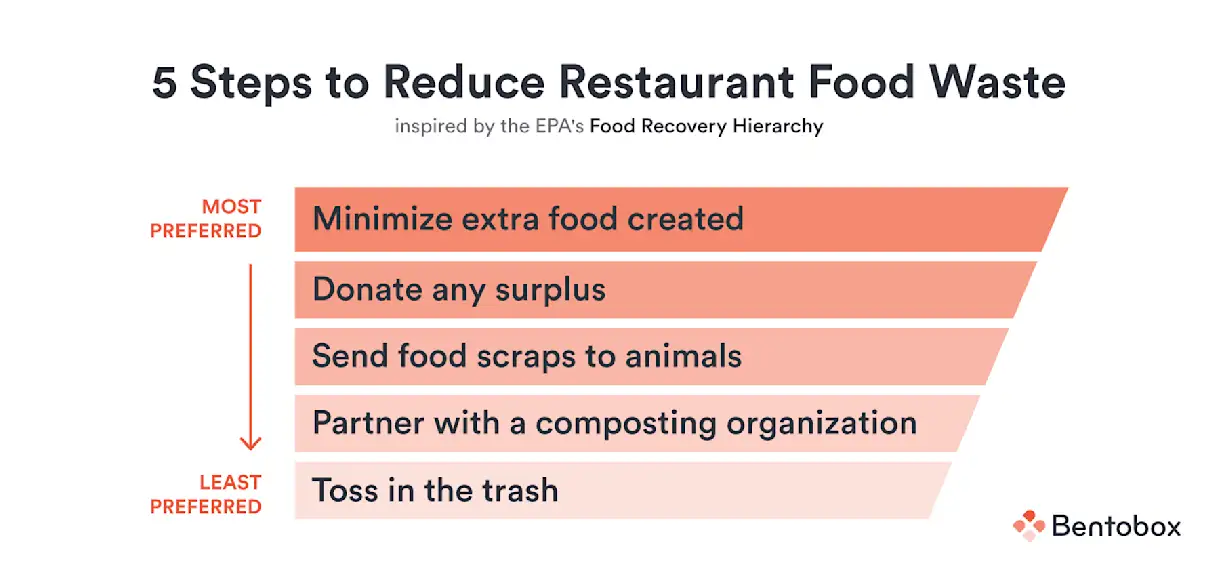Operations
How to Reduce Food Waste in Restaurants
Improve your bottom line, supercharge your sustainability practices and stay in compliance with state regulations using these tips.
Food waste has been a hot topic for the past few years — and for good reason. Restaurants and foodservice businesses in the United States generate 12.7 million tons of surplus food each year, with 75% going to landfill while just 13% gets composted and less than 1% gets donated.
The reality is that wasting food means wasting money, and in today’s financial climate, restaurants have no room for unnecessary losses. But minimizing food waste isn’t only good for business and profit margins: it’s also an important part of a restaurant’s sustainability efforts, which are definitely top-of-mind for diners.
Within the food recovery space, the Environmental Protection Agency (EPA) established a hierarchy model as guiding principles for how organizations can prevent and divert food waste. For those in foodservice, following a similar 5-step framework like the one below can be helpful.

Why Should Restaurants Care About Food Waste?
There are financial, social and legal reasons for hospitality workers to pay attention to food waste. This is true whether you work at a fine-dining establishment, fast casual spot or on-the-go food truck. The issue of restaurant food waste affects everyone.From a monetary perspective, wasted food has direct implications on overall operating costs. Socially, there is growing consumer interest in supporting businesses that actively manage and minimize food waste. And legally, many state DEPs (Departments of Environmental Protection) are passing restrictions on how much food you can toss.
1. Food waste impacts your bottom line
Champions 12.3, a collection of international stakeholders dedicated to meeting the United Nations’ Sustainable Development Goal of cutting global food waste in half per capita by 2030, conducted a three-year study of 114 restaurants across 12 countries. Its resulting report, The Business Case for Reducing Food Loss and Waste: Restaurants, found the following benefits for kitchens that implemented food waste reduction efforts:
For every $1 invested in reducing food waste in the kitchen, the average restaurant saved $7.
The average site saved more than two cents on every dollar of cost of goods sold (COGS) with the implemented tactics.
The report discovered three additional financial benefits of implementing a food waste reduction program. First, food waste audits alerted some restaurants to over-purchasing, which prompted them to buy less food and reduce overall food costs. Second, new menu items created from repurposed food generated revenue from ingredients that would have been wasted. And third, with less waste sent to landfill, restaurants saved on payments to waste management companies.
2. Diners care about sustainability practices
Diners are paying attention to how restaurants manage sustainability efforts and valuing businesses that demonstrate environmental stewardship. Back in 2018, the National Restaurant Association’s The State of Restaurant Sustainability Report shared that 55% of consumers consider a restaurant’s food waste reduction efforts an important factor when deciding where to eat. Newer research shows that 68% of consumers believe restaurants should have processes in place to avoid waste.
Restaurants that are meeting (or exceeding) their guests’ expectations in the fight against food waste should proudly share what they’re doing. Conveying your efforts enhances your brand and arms you with tangible examples to use in your marketing.Incorporating sustainability messaging into your website, menu, social media posts, tabletop signage and more can be a great way to communicate with your diners about your food waste philosophy. The National Restaurant Association has more tips on customer messaging about food waste.
3. Your state may have a commercial food waste ban
In the past few years, more and more states have passed legislation around commercial food waste bans, regulating how much surplus food and organic waste can be sent to landfill. You can check with your state’s Department of Environmental Protection for more details on restrictions and how they might affect you. ReFED’s Policy Finder Tool is another great resource for finding organic waste bans and waste recycling laws at both the state and federal level. Its State Score Sheet quickly outlines if your state has a waste ban policy in place.
How Can Restaurants Reduce Food Waste?
Acknowledging the global food waste problem and understanding the challenges it poses to your business are the first pieces of the puzzle. Now, how should you take action? Use these nine tips to get started — some are more difficult than others, but even simple changes can move the needle.
1. Perform a food waste audit
What gets measured gets managed is a cliché for a reason. Better understanding your waste stream can provide good insight into what’s working and where you can improve. Use pen and paper, a digital spreadsheet, or invest in a software.
"Leverage technology and tools and make sure you get a good amount of data, ideally across a span of at least 4-6 weeks, to really gauge how your restaurant is doing with food wastage," said Sam Smith, Senior Director of Marketing at Leanpath.
Here are a few templates and guides:
2. Understand your restaurant inventory management
Effectively managing your inventory and truly understanding the nitty gritty of what you source, store and sell can significantly help reduce unwanted waste.This isn’t the most glamorous part of running a restaurant, but it’s an essential one. Knowing your food cost variance number and how that translates into actual dollars is step one to growing your profit margin. Not only does regular inventory management prevent food waste, it also creates consistency in the guest experience which keeps your diners coming back again.
Read more here: The Ultimate Guide to Restaurant Inventory Management
3. Avoid ordering more than you need
Once you have a good sense of what’s coming in and out of your doors (thanks to stellar inventory management), it’s much easier to stop over ordering. This is waste prevention 101. Source reduction is key to making sure waste is limited. It can be tempting to take advantage of a bulk order sale through your supplier, or to want extra inventory on hand “just in case” — but without a plan for using this type of surplus, it can easily go bad before getting used. Your food waste audit will provide insight into your usage levels and highlight which products you often end up throwing away. Apply that knowledge to your ordering. Doing so can significantly reduce your food waste.
4. Improve storage practices
A popular inventory method and food storage system is FIFO, which stands for “first in first out.” In other words: Inventory that arrived on Tuesday should be used before any inventory that showed up Wednesday or later. This process keeps your kitchen organized, but it also supports food safety by planning for food to be used up before it goes bad.
Another storage tactic is to group similar foods together, which makes it easier to find and quickly take stock of each ingredient. Manually marking items with descriptive instructions like use by, use first, freeze by, etc. is also helpful.
Beyond using FIFO, grouping ingredients and labeling products, you can also improve storage practices by conducting regular audits of refrigerator and freezer temperatures and ensuring food is tightly wrapped and contained.
5. Use every part of your ingredients
Chefs are innately creative and always find unique ways to reuse surplus ingredients, like blending extra herbs, greens or carrot tops in pesto. Root-to-stem and nose-to-tail cooking prevents waste, but it can also feed into your brand ethos and storytelling. Diners love knowing the narrative behind the dishes including where the food came from, how it was made and what’s being done to use up the whole ingredient.
The special tasting menu formerly offered by 21 Greenpoint is one clever way to use up all of your ingredients. The New American spot in Brooklyn served a seven-course Sunday Night meal for only $21 that was entirely made with surplus food. Take inspiration from examples of ingenuity like this for your own special menus.
Read more here: How 8 chefs & bartenders upcycle food scraps
6. Consider a smaller menu
Smaller menus (or “narrow menus”) are shown to reduce food waste, and they’re on the rise post-pandemic. When a menu has fewer dishes, it’s easier to identify opportunities for ingredient repurposing (like the ideas mentioned above), whole ingredient utilization (ensuring every part of an ingredient has a plan) and cross-ingredient utilization (finding ways to use an ingredient in more than one dish).
As an added bonus, inventory management becomes simpler, food prep is more efficient and there’s more room for storage in your refrigerator (after all, fewer ingredients means less space used).
7. Offer half portions
Seventy percent of surplus food in restaurants is generated by plate waste from diners. However, offering half portions can minimize how much food diners leave on the plate. This strategy requires kitchen staff to be extra disciplined with portion sizes, but overall it offers a better and more customized guest experience.
8. Avoid unnecessary garnishes
Fresh herb garnishes like rosemary, thyme, mint and parsley often don’t get eaten. Your food waste audit will tell you if garnishes are consumed or chucked by diners, which can help you make the best decision for your restaurant. Save yourself prep time and money by avoiding adornments that hurt your bottom line.
9. Encourage innovation from your staff
A communal goal of minimizing food waste is most effective when employees buy-in and front-line workers feel backed by upper management.
It’s crucial to detach moral value from food waste so that workers do not feel like surplus is a negative display of their skills or the result of poor performance. If staff feel like identifying excess food will be a poor reflection on them, they are significantly less likely to report accurate data. Instead, you should strive to make a mindset of minimizing food waste part of your restaurant’s culture.
This starts from the very beginning of a new staff member’s journey, with onboarding that brings awareness to the issue. This amusing video from the National Restaurant Association can be a good addition to your training materials. Check out this resource for even more employee engagement ideas.
What To Do With Extra Food
Even with the best intentions and best laid plans, surplus food is inevitable. Here are three steps you can take before tossing excess in the trash, which should always be your last option.
1. Sell your surplus with discounted pricing
Did you know there’s a growing secondary market for surplus food? Restaurants can experiment with their own end-of-day sales or work with a partner like Too Good To Go to make back some money on products that weren't originally sold. Be strategic about how you turn your waste into value and know there are ways to monetize your surplus.
2. Donate unsaleable food
Consider donating food to local nonprofits like senior centers, crisis shelters, food banks & pantries, after school programs, veteran agencies, recovery centers and other organizations that support people struggling with food insecurity. Partnering with a food rescue organization is a great option because they will usually handle the logistics of pick up and distribution.
Sustainable America’s Food Rescue Locator is a good place to start for finding support.If you’re hesitant about the legal implications of food donation, don’t fear. The Good Samaritan Food Donation Act, which was passed in 1996, protects restaurants from criminal and civil liability when donating surplus food. Explore the USDA’s FAQs for more details.
3. Compost food scraps and organic waste
The final option before sending surplus to the trash is composting. FindAComposter.com will show you your nearby options. Remember, out of the 12.7 million tons of excess food created each year by U.S. restaurants and food service businesses, only 13% is composted with 75% going to landfill. Restaurants have a huge opportunity to work more with haulers and develop a comprehensive composting program.
How Tech Helps Restaurants With Food Waste
Technology is becoming a bigger part of a restaurant’s toolkit for managing its operations, digital presence, marketing and more. Waste reduction is another area where tech is leading the way by creating a more efficient, optimized and data-driven approach to managing surplus. Here are a few companies helping restaurants reduce food waste:
Leanpath - This B corp business focuses on the first part of the food recovery hierarchy: source reduction. It’s set on preventing waste from happening in the first place by powering you with the data you need to understand what’s being overproduced or discarded. Its scales and touchscreens bring a traditional food waste audit to a whole new level and enable you to weigh and track surplus. Plus, the tool shows the financial and environmental impact of the excess.
Winnow Solutions - Thousands of chefs across 45 countries are using this company’s products. Winnow Vision is a top-down camera and AI tool used to identify more than 600 foods that are trashed. The technology converts the value of the food into a dollar amount and, like Leanpath, calculates the environmental cost and financial implications in real time. The Winnow Waste Monitor is a more simplified version consisting of a digital scale and tablet that requires a manual identification of the surplus.
Copia - Copia is an all-in-one food rescue partner, enhanced tax deduction tracker and trend reporting tool. Its impact dashboards show you the value of your food donations, and emailed receipts for all donations make end-of-year taxes much easier.
Tenzo - Food waste management and prevention is just one part of what Tenzo manages. The platform is a data tool that syncs all of your systems — inventory, POS, staff scheduling and social media — into one place. From a food waste perspective, its technology compares vendor prices, identifies price hikes from suppliers, gives visibility on overspending and uses AI forecasting to predict sales & wastage for each dish.
Where To Start & Quick Links
Mitigating food waste is a process, and processes take time. It's OK — and sometimes even preferable — to gradually change your operating procedures, rather than trying to fix everything in one go.
One way to get started is taking the James Beard Foundation’s online course, Waste Not. The course covers the root of the issue of food waste, technical and creative approaches to minimizing waste, how loss happens across the entire supply chain and how chefs can become advocates for change.
For even more resources, check out the quick links below.
Quick Links

BentoBox Marketing & Commerce Platform
Minimize Food Waste, Maximize Profits
See why 14,000+ restaurants worldwide use BentoBox for websites, online ordering and event management.
Recommended

Operations
7 Restaurant Sustainability Best Practices to Know
April 19, 2023
A look at how and why restaurants are building sustainability into their brands.

Operations
How To Run a Profitable Restaurant
January 27, 2022
To run a profitable business, restaurants need to calculate their profit margin and know how to improve it.

Operations
10 Types of Restaurant Technology You Need in 2024
March 29, 2023
Your guide to picking the right tools that will support your restaurant's growth.


